

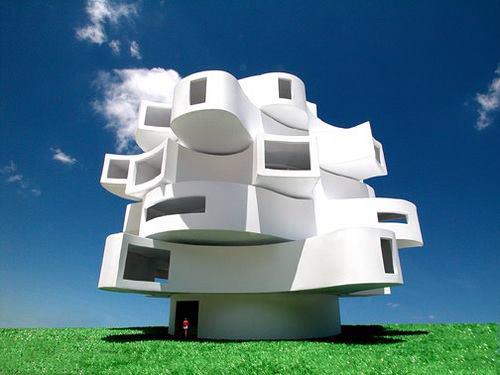

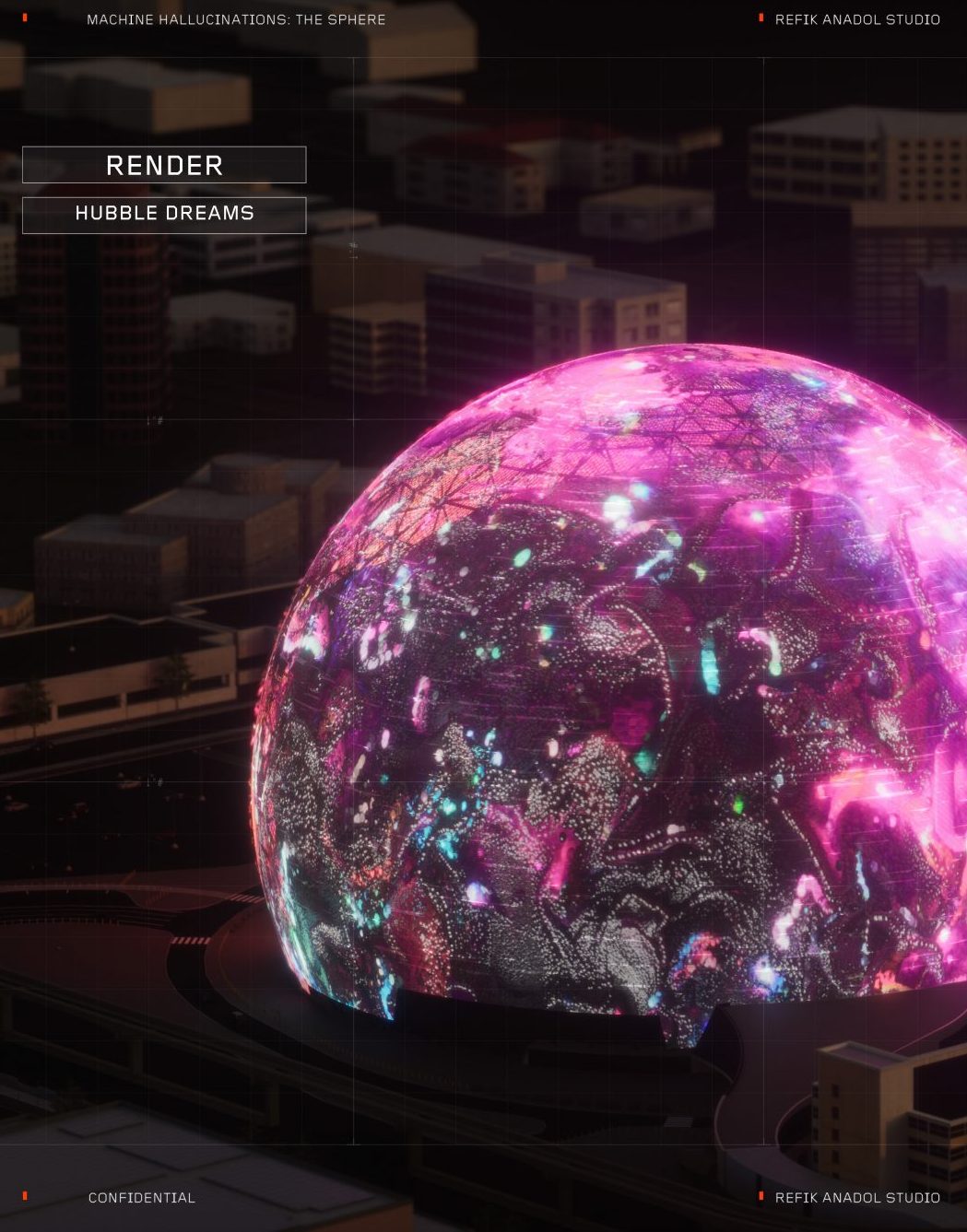
Refik Anadol
Machine Hallucinations — Sphere
The artwork presents a series of AI Data Sculptures that incorporates vivid pigments, shapes, and patterns, aiming to create a collective, meditative, and multisensory experience. This immersive experience simulates the rhythms of various environments and invites the visitors to imagine alternative realities constructed by invisible data movements around them.
Machine Hallucination: The Sphere features dynamic visualizations of data that are based on vast archives containing visual imageries of space and nature while celebrating the unique architecture of The Sphere. For this project, Anadol and his team used these themed datasets as the building blocks for the three distinct chapters of the artwork and trained a unique AI model with subsets of the collected image archives. After the training, when idle and unsupervised, the “machine mind” generates new aesthetic visuals and color combinations through unique lines drawn by algorithmic connections.

QUBIT AI: Hassan Ragab
Audio Responsive Treehouse
FILE 2024 | Architectural Synthetics
International Electronic Language Festival
Hassan Ragab – Audio Responsive Treehouse – United States
This work, created using generative artificial intelligence tools, is part of a broader exploration into discovering architectural forms through the intersection of different media. Potential shapes are generated based on the rhythms and timbres of the Shockone vs. Shockone song Run. The Bloody Beetroots. Factors such as camera movement and dynamics between the interior and exterior of the treehouse contribute to the creative process.
Bio
Hassan Ragab is an interdisciplinary media artist, architect and designer whose work focuses on the synergy between art, architecture, technology and humanity. He uses generative artificial intelligence to create a new visual language, and his work is exhibited globally. Additionally, Hassan writes about the integration of new media into art and design and has been recognized in numerous publications and news outlets.
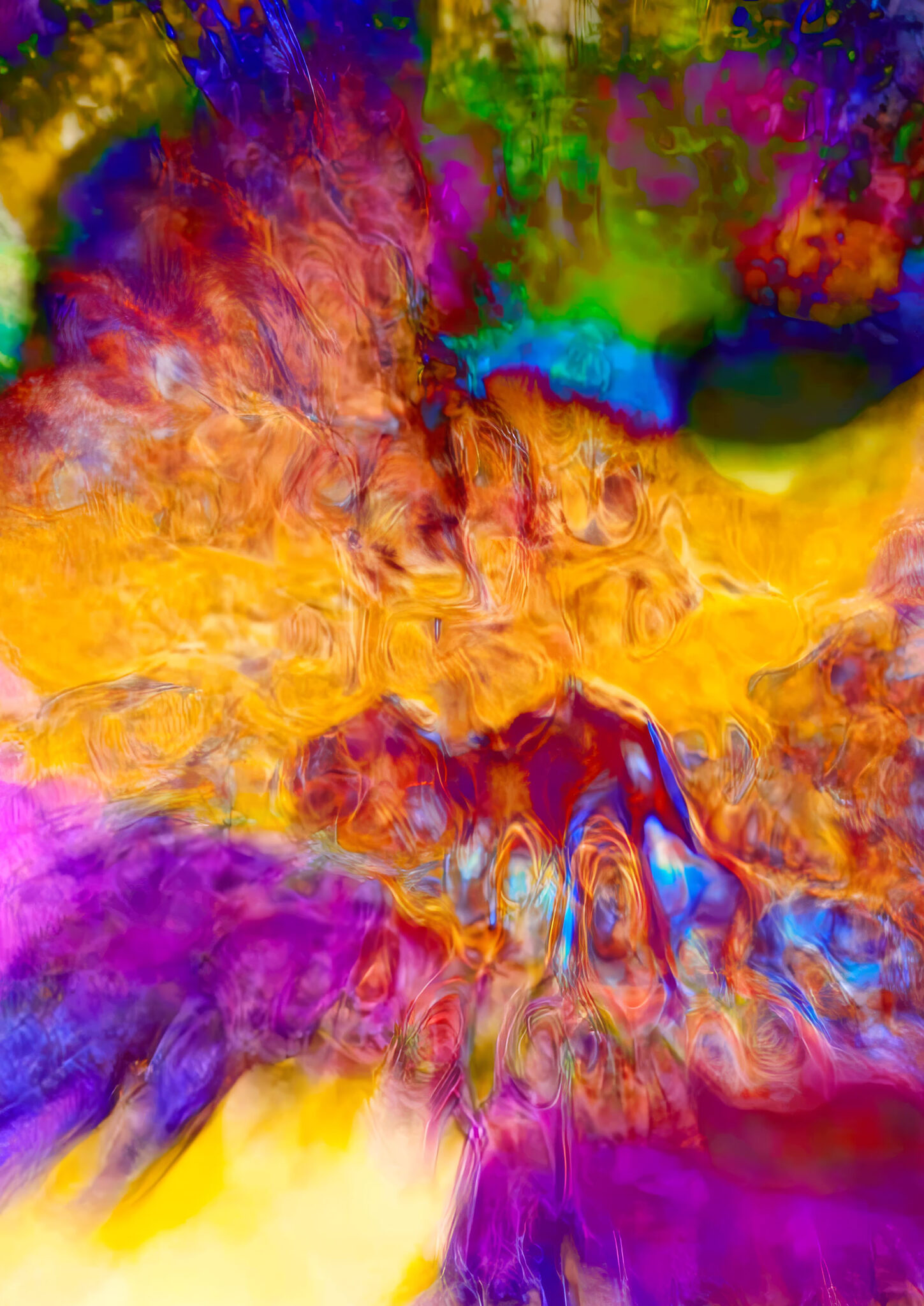
QUBIT AI: Michael Sadowski (aka derealizer)
Stealth Technology of Ancient, Cosmic Pantheons
FILE 2024 | Aesthetic Synthetics
International Electronic Language Festival
Michael Sadowski (aka derealizer) – Stealth Technology of Ancient, Cosmic Pantheons – Austria
An abstract painting in motion, with colors and shapes exploding and transforming to the rhythm of the music. The dynamic element is not trapped in a static image, but can unfold in time and space.
Bio
Using Stable Diffusion, a visual synthesizer, the artist turns fantasies into videos using just a PC, similar to the invention of printing 600 years ago. Exploring the interplay between software algorithms that create visual worlds and the artist’s mind guiding this process is incredibly exciting. Unlike traditional cinema, there is no ‘reality’ or humans involved, making it a satisfying medium for creating visual art.
Credits
Visuals: Michael Sadowski
Music: Stealth Technology of Ancient, Cosmic Pantheons by The Intangible

Beeple
Human One
This is the story of the first human born in the metaverse. Human One is the first dynamically changing hybrid digital/ physical artwork. The artwork is an ongoing journey that will continue to evolve over the course of the artist’s life.
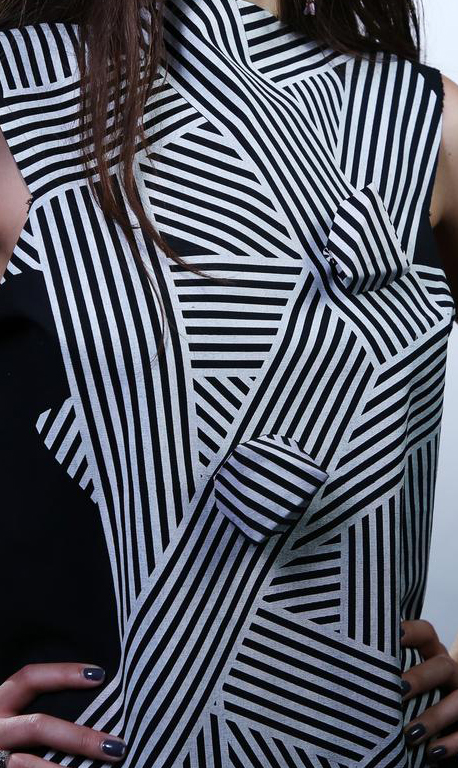
Kino
MIT Media Lab, Stanford University
This work explores a dynamic future where the accessories we wear are no longer static, but are instead mobile, living objects on the body. Engineered with the functionality of 18 robotics, this “living” jewelry roams on unmodified clothing, changing location and reconfiguring appearance according to social context and enabling multitude presentations of self. With the addition of sensor devices, they transition into active devices which can react to environmental conditions. They can also be paired with existing mobile devices to become personalized on-body assistants to help complete tasks. Attached to garments, they generate shape-changing clothing and kinetic pattern designs–creating a new, dynamic fashion.
It is our vision that in the future, these robots will be miniaturized to the extent that they can be seamlessly integrated into existing practices of body ornamentation. With the addition of kinetic capabilities, traditionally static jewelry and accessories will start displaying life-like qualities, learning, shifting, and reconfiguring to the needs and preferences of the wearer, also assisting in fluid presentation of self. We envision a new class of future wearables that possess hybrid qualities of the living and the crafted, creating a new on-body ecology for human-wearable symbiosis.

Frederik Heyman
CEREMONIAL FORMALITY
Frederik Heyman’s work is a balancing act incorporating multiple media – including video, installations and photogaphy – often in a digitally altered environment. In his work, Heyman explores memory and duration, using photogrammetry and 3D scanning to depict and represent the passage of time. The hallmarks of Heyman’s work are mechanical and technological: wires, wheels, scrolling LED marquees, metal frames, clamps, industrial lights, screens and cameras. Bodies–as opposed to humans–are subject to unusual dynamics with these technological trappings. In Ceremonial Formality (2020) a contortionist is encased in a metal cage while a spectator, hooked up to wires, looks on.

MARTIN HESSELMEIER & ANDREAS MUXEL
CAPACITIVE BODY
file festival
The installation “capacitive body” is a modular light system that reacts to the sound of its environment. Each custom-built module consists of an electro-luminescent light wire linked to a piezoelectric sensor and a microcontroller. Through its modular setup it can easily be adapted to various urban spaces. The sensors are used to measure vibrations of architectural solids in a range of low frequencies. These oscillations are triggered by surrounding ambient noise, for example traffic noise. The data sensor controls the light wires, which are tensed to a spatial net structure. According to the values of the measurement, light flashes are generated. With increasing vibrations the time between flashes becomes shorter and shorter. The stability of this nervous system gets to an end where it collapses and restarts again. A dynamic light space is thereby created, which creates a visual feedback of the aural activity around the installation.

Studio Smack
Tribe City
Hundreds of beings and dreamlike and dystopian elements inhabit the digital and autonomous works that are part of this project. “It’s a portrait of the masses,” summarise the artists, whose fascination with group dynamics, technological phenomena and the ego are expressed in Tribe with an eclectic selection of individuals who bring to life deeply recognisable social attitudes. Collective behaviour and manipulation are recurring themes in SMACK’s work, which often uses popular visual references and light-hearted aesthetics to present us with an uncomfortable reflection of who we are.

UVA UNITED VISUAL ARTISTS
Present Shock
Present Shock confronts the viewer with a barrage of statistical clocks representing real-time information about the world—from life-changing global events to the banal trivia of everyday existence—highlighting how the speed and volume of data in the Information Age present new challenges to our limited cognitive apparatus. Many of the statistics presented occur at timescales and spatial horizons that similarly defy our perception or comprehension. Disturbing the inertia of the here and now, they reveal the fluctuating state of dynamic transformation that characterizes life on earth.

MARTIN KALTENBRUNNER
reactable
file festival
The ReacTable is a collaborative electronic music instrument with a tabletop tangible multi-touch interface. Several simultaneous performers share complete control over the instrument by moving and rotating physical objects on a luminous round table surface. By moving and relating these objects, representing components of a classic modular synthesizer, users can create complex and dynamic sonic topologies, with generators, filters and modulators, in a kind of tangible modular synthesizer or graspable flow-controlled programming language.
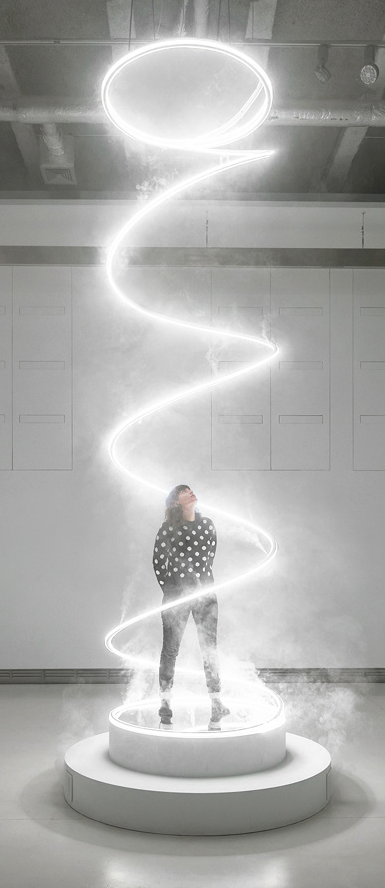
Karolina Halatek
Ascent
Ascent is a large-scale site-specific light installation that embodies a variety of archetypical and physical associations – from microscopic observations, electromagnetic wave dynamics, and atmospheric phenomena of a whirlwind to a spiritual epiphany. Most importantly, Ascent offers a unique immersive experience, that invites the viewer to become its central point, and transforms the perception of the viewer on a sensual level. The light and the fog create a monumental dynamic space that is participatory, the space that opens up a new dimension and directs the attention toward the bodily sensations in the explicit environment. The viewer is free to approach the work according to its own sensual response, but direct interaction can offer the potential to evoke a new perceptual imagination.
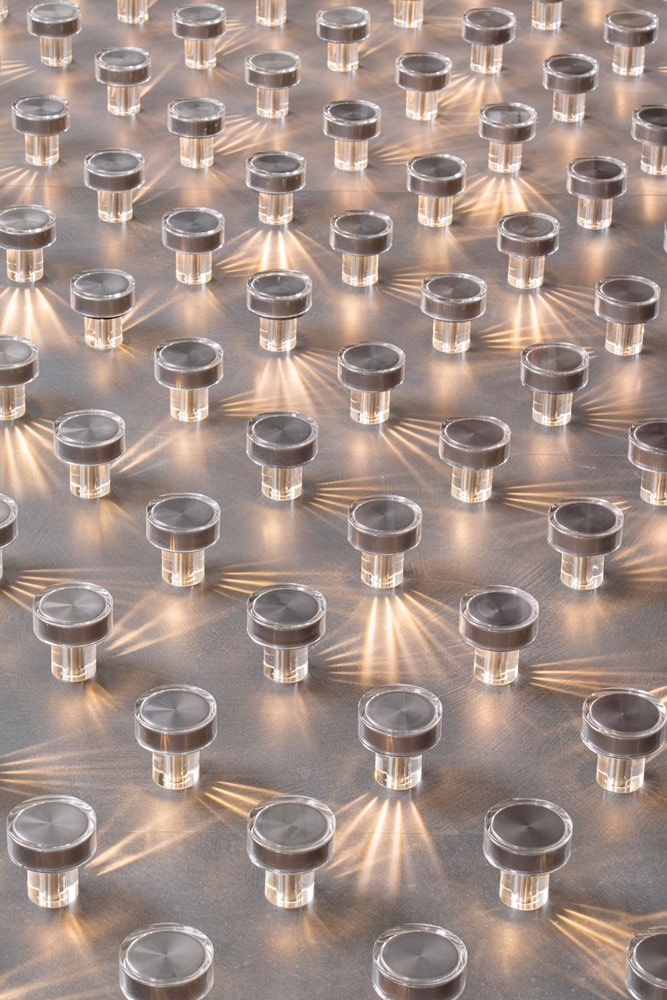

Playmodes Studio
“Espills” is a solid light dynamic sculpture. Built using laser beams, laser scanners and robotic mirrors, it is inspired by crystalline formations. A set of geometric figures that float in the air and which suggest, in an abstract way, the transmutation of matter from chaos to order. Dust becoming crystal, being eroded and becoming sand again.
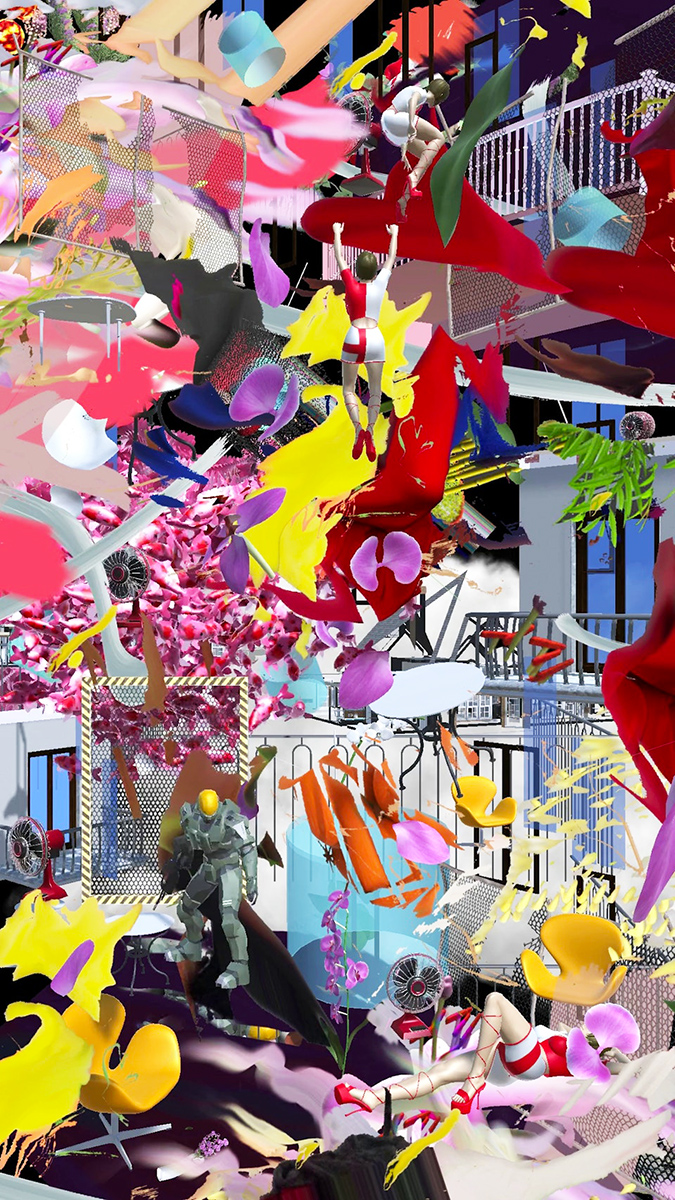
Cassie Mcquater
Halo
In these six animated paintings presented as a single channel video, the artist reenacts situations and motifs from the first-person shooter series Halo and the erotic videogame Dream Stripper. Conceived as a dynamic, virtual collage, HALO shows short stock animation loops of characters dying over and over, with koi, dining chairs, asteroids, guns, flowers, torches, pinball machines, candles, and discarded pillows floating around them, creating a hypnotic motion.

Lundén Architecture Company
Another Generosity
Another Generosity explores a new structure that consists of a membrane holding two basic elements: air and water. The simple structures are combined to create a visible and dynamic cellular structure. The inflated elements mediate between the natural and built environment. They respond to external and sometimes unseen stimuli, creating a new kind of experience, a momentary hesitation that heightens our awareness of our surroundings.

Kenny Wong
Squint
file festival
I was inspired by how the sunlight bounces around in our artificial forest.
“Squint” is a kinetic light installation consisting of 49 mirrors that reflect lights in a bright space. The mirrors track and reflect lights on audiences’ face with composed patterns of movements. It extends the generated perception by focusing on how lights pass across our visual senses physically, and combines with our perception of images through flickering. “Squint”, which extracts various daily experiences to an abstraction brings the audience to expand their interpretation of lights and perceived imagination into a non-linear experience.
“Squint” simulates light source and intentionally shines lights on audience’s faces. Bright light is projected in the gallery, a clean bright space.
Everyday people are dynamically moving around in the city. Sunlight reflects and flickers even when it is indirect and hidden behind the artifacts. While we are traveling, we are experiencing motion. We are also experiencing the shift of light intensity, visual patterns and textures. The varieties of light forms inspire the artist to explore the potential of light textures, select and sort out the combined complexity in urban space. The artist turns them into a minimal form of light experience, while maximizing its diversity of perception.

zach blas
sanctum
Zach Blas(United States、1981)の作品は、テクノクラート社会の限界と基盤を描くことを目的として、視覚言語の慣習、価値体系、デジタル技術に内在する力のダイナミクスをさまざまな文脈で分析、調査、配置しています。 。 彼の分析とデジタル文化への反映のために、彼は映画、彫刻、執筆、パフォーマンスなど、さまざまな表現形式を使用しています。 ブラスはブラックユーモアと理論的研究に取り組んでおり、彼の最も顕著な影響の中には、神秘主義の伝統、サイエンスフィクションのジャンル、ポップカルチャー、クィアの美学があります。
.
sanctum
The work of Zach Blas (United States, 1981) analyzes and explores the dynamics of visual language practices, value systems, and the forces inherent in digital technology in a variety of contexts, with the aim of depicting the limits and foundations of technocratic societies. I have placed it. .. For his analysis and reflection in digital culture, he uses a variety of forms of expression, including film, sculpture, writing and performance. Brass works on black humor and theoretical research, and among his most prominent influences are the mystical tradition, the genre of science fiction, pop culture, and the aesthetics of queer.

Maria Takeuchi & Frederico Phillips
asphyxia
The performance is centered in an eloquent choreography that stresses the desire to be expressive without bounds. Motion data was captured using inexpensive sensors and that data paved the way through an extensive number of steps. Once all the scanned point cloud data were combined, they were used as the base for the creative development on the piece. A series of iterative studies on styles followed and several techniques and dynamic simulations were then applied using a number 3D tools for various results.

TERMINALBEACH
The Heart Chamber Orchestra
File Festival – Hipersonica
In the TERMINALBEACH Heart Chamber Orchestra (made up of artists Erich Berger and Peter Vatava), twelve musicians played pieces from the heartbeat, recorded by an electrocardiogram from data sent by sensors placed on their bodies. As the live score created in real time from the physical and emotional states of the musicians, their beats further influenced the resulting musical composition. In this way, the biological feedback loop becomes a self-generating, organic and evolving system, which creates a musical score and a show that adopts the form of open or network art, in which chance and interdependence, thus how emotional changes and computational reasoning create a biological and psychological dynamic at the same time.

NICOLAS SCHÖFFER
ニコラ·シェフェール
Chronos 5
In 1948 he created the concept of “space dynamism”. In his words, space dynamism is “the constructive and dynamic integration of space in plastic work.” Based on this idea, he will seek to create the total work of art, concretized in the cybernetic village, a city full of utopian spaces. His work combines cybernetic, kinetic art and interactive art, of which he is one of its first representatives, making the first works of art in real time or live in the history of art.

Ian Cheng
“Entropy Wrangler,” Ian Cheng’s 2013 exhibition at Off Vendome in Dusseldorf, was an excellent introduction to the logic behind this artist’s practice. The centerpiece was a large projection in the gallery’s basement described as “a live computer simulation that changes and evolves, forever.” Like all of Cheng’s simulations, it was programmed with motion capture techniques that register the physical movements of performers that are then translated onto digital bodies. These bodies coexist as individual entities subject to the laws and dynamics of a causal, virtual world: avatars of people and common objects, like hammers and basketball players, rendered in basic three-dimensional form and caught in the zero gravity of the digital screen

MEMO AKTEN
Body Paint
File Festival
The interaction is simple, movement creates paint. Hidden in the simplicity are layers of subtle details. Different aspects of the motion: size, speed, acceleration, curvature, all have an effect on the outcome: strokes, splashes, drips, spirals; and is left up to the users to play and discover. The installation is designed to work with any number of people and is scalable to cover small or large areas. While the installation is suitable for a single user, when multiple users are present a new dynamic emerges. A user-to-user interaction is born when the audience starts playing with each other via the installation, throwing virtual paint on each other, trying to complete or destroy each other’s paintings.

Ann Veronica Janssens
Hot Pink Turquoise
Janssens’ works range wide, but they can all be described as sculptures that use the space as a stage for sensory activity. The simple white architecture of Louisiana’s South Wing becomes a resonating surface for Janssens’ both fragile and dizzying art – fragile because the works and their components are very simple while their effect elevates them above the material. Janssens herself often uses the word ‘fluid’ to describe the effect of her works – even for example when they consist of a 6.5 metre long iron girder polished at the top so the room is reflected and it is hard to fix your gaze on the object. Janssens seeks no control of either works or viewers, for as the Dutch theorist Mieke Bal has said, Janssens’ artworks are at one and the same time object and event. Many of the works in the exhibition can evoke the sensation of standing at the threshold of something. They stress transitions and transformations between on the one hand a material level – evoked by glass, colour, liquids and not least light – and on the other hand a dynamic experience of time and space.

Maki Namekawa
Pianographique
Pianographique is a series of collaborations of real time visual artist Cori O’Lan and Maki Namekawa. The visualisations are not videos that are more or less synchronous to the music and it is also not the musician’s playing to prefabricated material, they are jointly created together in the moment of the performance. As with most of Cori O’Lan’s visualizations, all graphic elements are derived directly from the acoustic material, i.e. the sound of the music. For this purpose, the piano is picked up with microphones and these signals are then transformed by the computer into a multitude of information about frequency, pitch, volume, dynamics, etc… This information, in turn, is used to control the graphics computer, create graphical elements or modify them in many ways. Since these processes take place in real time, there is a direct and expressive connection between the music and visual interpretation. The visualization is actually not “created” by the computer but much more by the music itself – the computer is rather the instrument, the brush operated, played by the music.

BANDALOOP
100 Northern Ave
You’ve probably never seen anything like this before. Six members of the vertical dance troupe BANDALOOP descended the façade of the new 100 Northern Ave. building commemorating its grand opening at Boston’s Seaport District. The performers are held securely by special rigging allowing them to mesmerize audiences with dynamic physicality and intricate choreography. BANDALOOP honors nature, community, and the human spirit through perspective-bending dance. A pioneer in vertical performance, BANDALOOP seamlessly weaves dynamic physicality, intricate choreography and climbing technology to turn the dance floor on its side. Under the artistic direction of Amelia Rudolph, the work re-imagines dance, activates public spaces, and inspires wonder and imagination in audiences around the world.

Paul Vanouse
Labor
What does labor smell like? Labor is a dynamic, self-regulating art installation that re-creates the scent of people exerting themselves under stressful conditions. There are, however, no people involved in making the smell – it is created by bacteria propagating in the three glass bioreactors. Each bioreactor incubates a unique species of human skin bacteria responsible for the primary scent of sweating bodies: Staphylococcus epidermidis, Corynebacterium xerosis and Propionibacterium avidum. As these bacteria metabolize simple sugars and fats, they create the distinct smells associated with human exertion, stress and anxiety. Their scents combine in the central chamber with which a sweatshop icon, the white t-shirt, is infused as the scents are disseminated. The scent intensifies throughout the exhibition.

Mathias Krissmer
II00II0I0I00II000I
“Krissmer’s ‘Kinetic Paintings’, explore visual composition, movement and scale in a way that thrills and disorientates. They are an optical experience simultaneously aesthetic and perceptual. The digital projections can be taken to any scale making them architectonic and potentially intimate. Their focus on a geometric language set in dynamic movement creates a certain sculptural juxtaposition, enhanced by the predominant use of black and white. The occasional introduction of bright colours further dramatises the Krissmer aesthetic. These are works that inspire, that must be experienced by the mind and the body.”
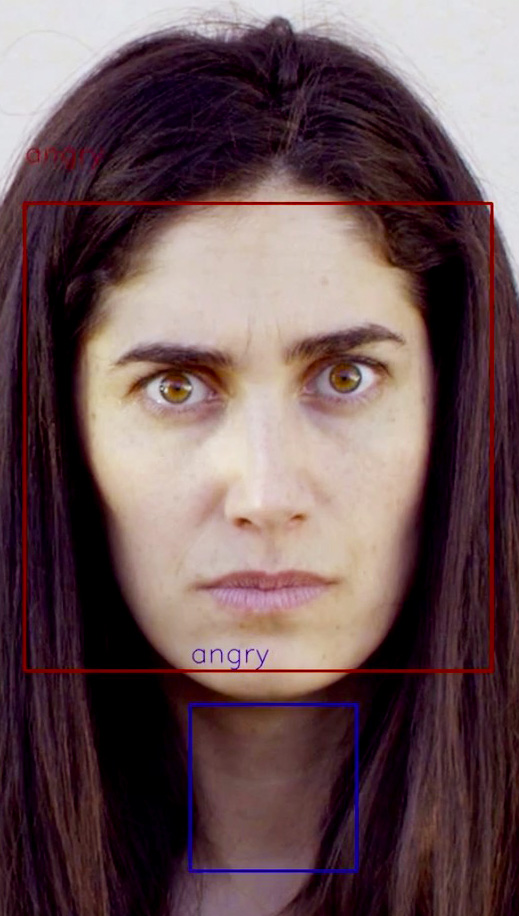
Thomas Depas
Princess of Parallelograms
What will happen when our imagination itself is externalized in machines? Artificial intelligence constructs its own world-truth that is beyond our sensory perception. Generative Adversarial Networks (GANs) use algorithms to synthesize and generate images in a completely new way. These images have almost uncanny aesthetic characteristics, seeming to emerge from an ocean of data, a kind of pixel soup. Rather as if we were observing the emergence of artificial “thought.” The machine learns to understand the “essence” of a thing, be it an animal, the face of a celebrity or a body of text. It is then able to generate new images of this thing, including faces of celebrities who do not exist, mutant animals, or new texts. Eventually, AI will be capable of instantaneously and dynamically emulating all representations. The era of the optical machine and the capture of reality will then be at an end, supplanted by the era of machines that generate their own reality.

Thibaut Sld
S1 Pendant Light
S1 is an interactive pendant light. Its brightness and height are adjusted according to human presence. Units can be combined to generate dynamic patterns.
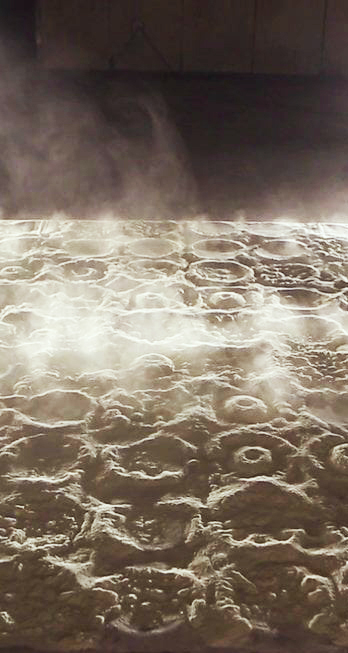
Intermedia Chef
The Half
New media artist group, Intermedia Chef is trying to explore dynamic artwork generated by computer-controlled sound in the aspect of data visualization. The sound installation artwork transits sound wave into physical movement. Overmore, they are aiming that the sound wave energy turns out a kinetic type of visual art.

Kerstin Ergenzinger
Wanderer Spacetime Poetry
Wanderer Spacetime Poetry is a continuously evolving installation series. Wanderers are small modified and individually programmed thermal printers that roam along paper strips that are stretched in different constellations across a space. On their journeys the Wanderers leave traces behind, a line, a dot or words. Like a snail with its trail the units dynamically create a poetic drawing over the course of an exhibition.
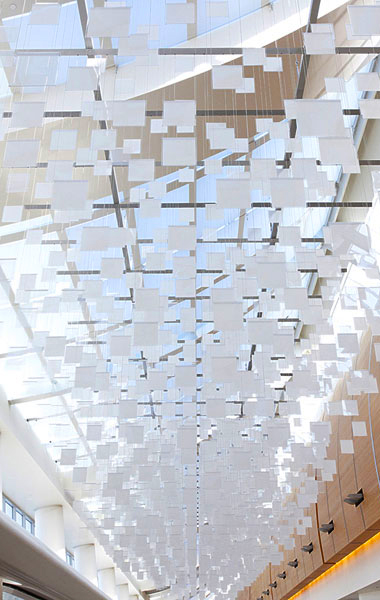
Dan Goods, Nik Hafermaas & Aaron Koblin
eCLOUD
The eCLOUD is a dynamic sculpture inspired by the volume and behavior of an idealized cloud. Made from unique polycarbonate tiles that can fade between transparent and opaque states, its patterns are transformed periodically by real time weather from around the world. It is a permanent sculpture between gates 22 and 23 at the San Jose International Airport and was a collaboration between Dan Goods, Nik Hafermaas, and Aaron Koblin.

EMILIJA ŠKARNULYTĖ
Mirror Matter
In the neutrino observatory rendered in Mirror Matter, slow panning movement gives a sense of the immensity of the nearly 13,000 photo-multipliers that inhabit this strange vessel – their ‘eyes’ engineered to watch light. Another frame depicts the Hadron Collider at CERN; its architecture envisioned through lidar scans, producing a dynamic, transparent imprint in three dimensions. Described as a vision that flows through the body, it is imagined by Škarnulytė as ‘alien archaeological vision’ with the ability to see through, and as the experience of sight farthest from the human realm. Through simultaneous perspectives, the constant surveying motion that weaves a continues thread through each video narrative, and the immersion generated by the reflective black ceiling, the viewer is imparted with this panoptical mode of perception.

Patricia Olynyk
Oculus
Oculus is a large-scale, collaborative light sculpture that depicts a colossal abstracted drosophila eye, replete with compound faceted surfaces. It both recalls the circular opening at the apex of a cupola and alludes to a surveillance device or drone hovering in mid-air. Oculus is inspired in part by a series of scanning electron micrographs produced in a transgenic lab while researching human and non-human sensoria. The work evokes affective encounters with scale such as viewing miniature particles through the lens of a microscope or wandering through monumental physical environments. As each viewer’s reflection plays across the sculpture’s undulating surface, the apprehension of the self affects both individual and collective behavior in unexpected ways. This affective dynamic plays on the precariousness of our coexistence with other lifeforms in the world, one that is always contingent upon viewers’ bodies and the variability of the environment around them. The act of gazing at Oculus also puts into play the reciprocal condition of both seeing and being seen.

Lerata and Arts Brookfield
Lumibolic
Lumibolic is an interactive and occupiable environment shaped from hyperbolic paraboloid geometries. Its luminous surfaces are composed of strands of glowing EL wire that modulate their form and intensity in response to sound and motion inputs. Designed to generate dynamic visual vibrations inspired by the work of Op-Artists Bridget Riley and Victor Vasarely, the piece visualizes relationships between site and visitor on a large scale.

Mika Tajima
New Humans
In New Humans, emergent gatherings of synthetic humans rise from the surface of a black ferrofluid pool. Appearing to morph like a supernatural life form, these dynamic clusters of magnetic liquid produced by machine learning processes are images of communities of synthetic people–hybrid profiles modeled from actual DNA, fitness, and dating profile data sets sourced from public and leaked caches. The work questions how we can radically conceptualize the “user profile” to embody a self whose bounds are indefinable and multiple. Generative algorithm using machine learning (GAN, T-SNE) and fluid simulation (Navier Stokes), countour generation (OpenCV), user profile data caches (DNA, fitness, and dating), software production (Processing), ferrofluid, custom electromagnet matrix, custom PCB control system, computer, steel, wood, aluminum.

Marnix de Nijs
Lost Dimension
Lost Dimension Non-dimensional Cities is an immersive cinematic experience in which participants journey through an endlessly unfolding virtual cityscape that expands over all axes. This dimensionless cityscape is constructed from a large collection of point clouds and sounds. While the user is standing on the controller pod and navigates through this virtual world, a sense of physical instability takes over and the platform becomes an anchor to hold on to. The building blocks of the world are generated from depth map information and panoramic photographs obtained from Google Street View’s API. Depending on the user’s position in the virtual world these blocks are dynamically repositioned on a three-dimensional grid. By subtle manipulation of motion and sound, perspective distortion and shifts in balance Lost Dimension unquestionably re-calibrates the viewer’s perception of dimensionality.

Anke Eckardt
Between I you I and I me
BETWEEN | YOU | AND | ME is a wall of sound and light. Like any other wall, it defines an architectural space. Given its ephemeral, dynamic media – ultrasound and beams of light – the wall can be perceived only when the visitor comes close and interacts with it. Two thin membranes of light form a visible frame filled with sound. Multichannel, extremely vectored hypersonic speakers render audible various textures of broken glass: a sound architecture within the wall, comprised of juxtaposed single sound beams, whose constellation changes depending on the visitor’s position. Observed from a distance, the wall fades away: clear transparency and only faintly resonant tones attest to its non-existence.

Golan Levin
Ghost Pole Propagator II
Ghost Pole Propagator captures and replays the ‘skeletons‘ of passersby in its environment, creating a layered and dynamic tapestry that reflects the history and activity of a locale. Presenting a universal communication of presence, attitude and gesture, the stick-figures this artwork generates are compact and expressive means of representing the human form. The format of the work is variable; in some presentations, the project serves as a kind of ‘interpretive monitoring station’ for nearby pedestrian traffic.

Josiah McElheny
Interactions of the Abstract Body
With ‘Interactions of the Abstract Body’ McElheny pushed these ideas further, creating a large and varied body of work that looks at how fashion and modernism have intersected and influenced each other, especially through the common language of the body. Crucially, McElheny animated this dynamic with the constant presence of a performer. By combining a continuous flesh-and-blood performance with static sculpture in the same gallery space, a first for White Cube, McElheny radically fractures the distinction between performance and exhibition.

alexander lehmann
Hybris – Garbage Truck
Inspired by chaos theory and non-linear dynamics, Hybris invested a few years sitting in the studio to create his debut, and the results of such an amount of time invested in it stand out at first glance because not only has his head blown of how much ordinary human being crosses his music in addition to blowing the minds of Noisia themselves (who surely do not have to be very easy people to surprise), it has also made UKF (the largest d & b / idm community the world) highlight his first single as a piece worthy of freezing in time and that somehow revitalizes and reinvents the d & b that in Hybris Garbage Truck has not only found a new form of expression with what you hear but also with what you see with his precise and perfectly timed video made by Alexander Lehmann.

AADRL
Project Orb[i]s
Orbis is a proposal for a Prototypical System, which is highly adaptive in nature, and creates an urban infrastructure that responds and caters to the changing needs and conditions within the city, by augmenting the everyday experiences and activities. Orb(i)s is a behavioral assembly that establishes the possibilities of a dynamic environment not limited to a building plan; rather, it is autonomous, adaptable, dynamic and self-assembling based on real-time data culminating in a constantly reconfiguring ecology. The sensing abilities of the system make it self-aware and encourage any decision-making, while its self-assembling quality arises from a unit-to-unit communication that leads to a higher order of organizations and structures.

Danielle Wilde
LASERSPINE
A garment with lasers that project perpendicular to, and down the length of the spine. The complex technology in this interface is the body. Though it is not always evident, the range of movement of the spine is remarkable. Magnifying and making visible the relative position and dynamic tilt of the spine is sufficient to bring attention in an intense and unique way to this part of the body. That the wearer of the garment cannot see the lights projecting from their back serves to intensify this focus. The whole seems to enhance the poetic valence of movement of the entire torso, with the spinal column demarcated as the experiential, physical and energetic core.
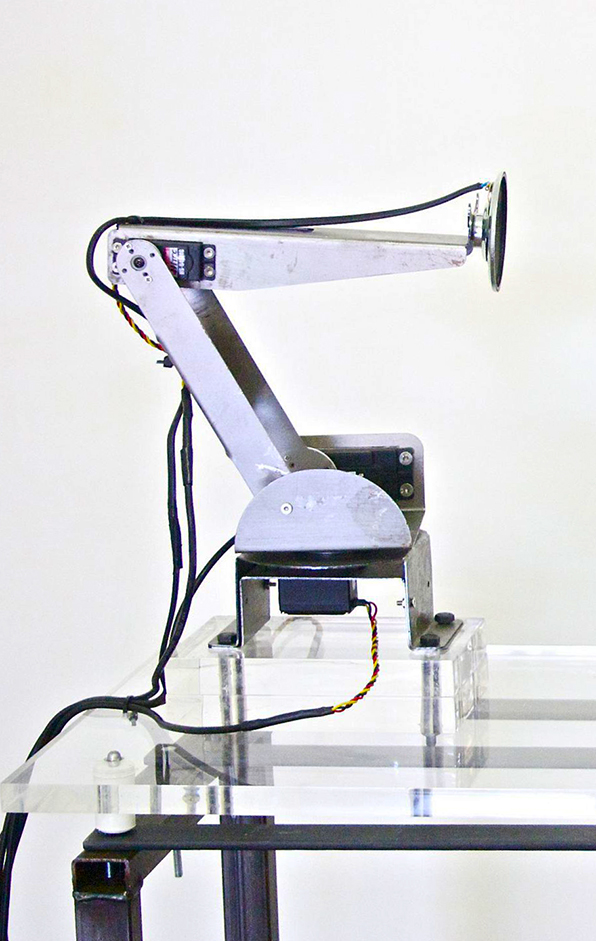
Roberto Pugliese
Equilibrium Variant
This work has the purpose of exploring the occurrence of the Larsen effect (also known as feedback) through the use of mobile devices in a three-dimensional space. The distinctive screech of the Larsen effect typically occurs when a microphone catches the sound emitted by a speaker. It engages when the microphone is located too close to the speaker, and gets in the way of its frequency. The microphone amplifies and reproduces the speaker’s frequency with an ever-increasing width, virtually unlimited, in practice stopped by the amplifier’s clip. On a ground support, two mechanical arms are located. At the end of one arm there is a microphone, and on the end of the other there is a speaker. A software, created with this specific purpose, manages the position of the arms in a dynamic way, and provides that the distance between the microphone and the speaker never causes the amplifier to clip. This way, the system tends to reach an equilibrium that is physically impossible to attain. The struggle to balance creates an acoustic and visual dimension that is never the same: the frequency of feedback and the movements of the mechanical arms are always different and change in real time.

Alisa Andrasek
Cloud Pergola
Inspired by the cloud formations and weather events, this mathematized cloud plays with visitor’s perception. Movement through the structure generates a series of dynamic interference views in its deep fabric, drifts and ruptures in visibility. A sea of redirecting vectors is pulling the visitor like an invisible gravity force through the fabric.

Anne-Sarah Le Meur & Jean-Jacques Birgé
Omni-Vermille
Omni-Vermille is based on computer-generated real-time 3D images. The programmed code allows light spots to oscillate against a dark background. The colors sometimes move dynamically, sometimes calmly across the projection surface; sometimes they evoke plasticity, sometimes depth. This continuous metamorphosis endows the contents of the images with a sensual, even lively quality. The metamorphosis designed by algorithms opens up a new time-based morphology of colors and forms for painting. The play of colors is accompanied by a stereophonic sound composition by Jean-Jacques Birgé (*1952, France). The sounds follow the shapes of the colors, only to stand out again the next moment: the combination of sound and image results entirely from the laws of random simultaneity.

Christoph De Boeck
Staalhemel
The intimate topography of the brain is laid out across a grid of 80 steel ceiling tiles as a spatialized form of tapping. The visitor can experience the dynamics of his cognitive self by fitting a wireless EEG interface on his head, that allows him to walk under the acoustic representation of his own brain waves.The accumulating resonances of impacted steel sheets generates penetrating overtones. The spatial distribution of impact and the overlapping of reverberations create a very physical soundspace to house an intangible stream of consciousness.‘Staalhemel’ (‘steel sky’, 2009) articulates the contradictory relationship we entertain with our own nervous system. Neurological feedback makes that the cognitive focus is repeatedly interrupted by the representation of this focus. Concentrated thinking attempts to portray itself in a space that is reshaped by thinking itself nearly every split second.

